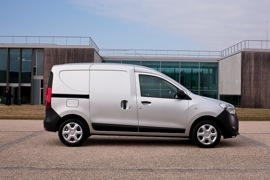DACIA Dokker Van Models/Series Timeline, Specifications & Photos
First production year: 2012
Engines: Gasoline, Diesel, Natural gas
Body style: Van
The Romanian automaker Dacia released a new light utility vehicle in 2012 based on the same platform as the Dacia Lodgy, launched at the beginning of the same year.
Renault’s budget brand, Dacia, was highly appreciated in Europe thanks to its robust construction and low maintenance costs. Previously, it covered a big chunk of the light-utility vehicles with the Dacia Logan Van, which was discontinued in the summer of 2012. Unlike that model, which was based on the Logan MCV (station wagon), the Dokker was developed right from the start to become an LCV. As a result, it boasted a taller interior loading space and sliding doors, which were much more convenient than the hinged ones from its predecessor. Dacia also made the Dokker as a five-seat vehicle, and that recipe worked better than the Logan MCV. Even though the overall design wasn’t the best in its class, or its features were not on par with what other automakers offered, it managed to convince customers since it was budget-friendly.
With its short and tall front, the Dokker couldn’t win any beauty contest, but it was practical. Base versions sported black and unpainted wrapped-around bumpers. Above them, the automaker placed the same headlights as those installed in the seven-seat Lodgy. Dacia’s chromed badge took center stage on the hexagonal grille that was adorned by two horizontal slats. On the higher grades, the automaker installed body-colored bumpers and round fog lamps that flanked the lower air intake.
Dacia tried to create a compact-sized but roomy utility vehicle. To achieve that, it had to make short overhangs and a spacious cabin. As a result, the hood was tall, which couldn’t be concealed by the addition of enlarged fenders. In addition, the steep windshield was continued on its upper side by the roof in an ascending line. For the passengers, the automaker installed hinged doors, while for the cargo area, it placed sliding ones on both sides. The pre-cut areas used for windows in the passenger version were visible, albeit covered with sheet metal. Finally, at the back, the automaker placed unequal rear doors. Like the front bumper, the rear one was black for lower grades, while the higher versions were fitted with body-colored ones.
With a cabin fit for two and a dashboard made from hard plastic, the Dokker was not the most attractive car on the block. But its simple design and functionality impressed customers. There were plenty of storage areas on the dash, underneath it, in the door cards, and on the center console. Furthermore, there was also a storage area above the windshield. Fronting the driver was a mundane instrument cluster featuring a large dial for the speedometer that took center stage, flanked by the tachometer on the left and by an LCD display on the right, which showed data from the car’s onboard computer and the fuel gauge. At the back, the cargo area had a 2,420 liters (85.5 cu-ft) volume, which could be extended to 3,300 liters (116.5 cu-ft) with the side passenger seat folded down.
Under the hood, Dacia installed a choice of gasoline and turbodiesel engines paired with either a five or a six-speed manual, depending on the version. It wasn’t the fastest vehicle around, but it did its job properly and boasted a low fuel consumption, especially for the oil burner variants.
